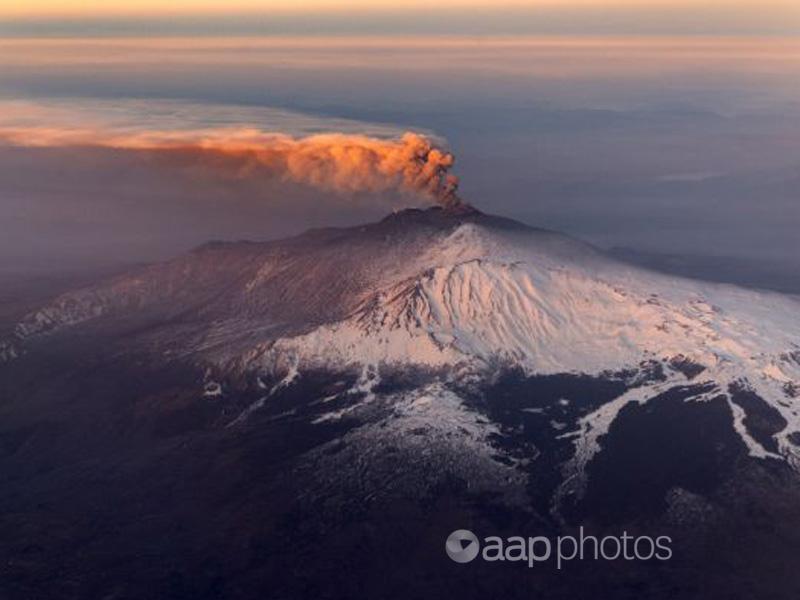The Statement
The claim that human-caused carbon emissions are a drop in the bucket compared to greenhouse gases from volcanoes has been making its way around the internet and social media for years.

Numerous claims that the greenhouse gases pumped about by volcanoes in Indonesia, The Philippines, Iceland, Italy or by all volcanoes worldwide are greater than the combined carbon emissions of all humanity have been made, typically in attempts to criticise action to reduce emissions and combat climate change.
A February 3, 2020 post on a Facebook page called The Greens Little Bag of Stupidity features an image of a volcanic eruption with the title, “For all you environmentalists …” The text reads, “That one little burp by Mt Etna has already put more than 10,000 times the CO2 into the atmosphere than mankind has in our ENTIRE time on earth but don’t worry a scam is in the works to tax you your miniscule footprint….”
The Greens Little Bag of Stupidity page has more than 6800 likes. The post has been shared more than 500 times and attracted more than 300 reactions and 30 comments.
The Analysis
The post’s claim that a volcanic eruption puts more carbon dioxide, or CO2, into the atmosphere than the amount generated by mankind over history echoes a similar post in December 2009 which claimed “Mt. Saint Helen’s volcano eruption put more toxic fumes, carbon dioxide, carbon monoxide etc. into the atmosphere than all of the emissions from all of mankind’s pollution from day one to now.”
AAP FactCheck found the earliest example of the Mount Etna post could be traced back to at least January 2016.
AAP FactCheck examined a volcanoes-and-emissions claim in September 2019 regarding Bali’s Mount Agung and another from December 2019, which labelled efforts to reduce carbon emissions as pointless, claiming carbon emitted from volcanic eruptions had undone all human emissons reduction efforts.
The volcano Mount Etna lies on Sicily’s east coast and is about half a million years old. It is Europe’s most active volcano and is also a UNESCO-listed World Heritage Site.
Mount Etna has a long history of eruptions dating from July 2019 to the B.C period, according to the Smithsonian Institution and National Geographic. Etna’s most destructive incident occurred in 1669, when lava flowed for four months, killing 20,000 people and destroying the Italian city of Catania and several neighbouring villages.
A 2011 paper from the United States Geological Survey (USGS) specifically addressed the question of carbon dioxide emissions from Earth’s volcanoes versus human activities.
USGS scientist Dr Terry Gerlach wrote in the paper that: “The climate change debate has revived and reinforced the belief, widespread among climate skeptics, that volcanoes emit more CO2 than human activities. In fact, present-day volcanoes emit relatively modest amounts of CO2, about as much annually as states like Florida, Michigan, and Ohio”.
University of New South Wales physical meteorology and atmospheric climate dynamics expert Professor Steven Sherwood told AAP FactCheck in September 2019 that “on average over time, volcanoes emit about one per cent as much CO2 as humanity.”
“Humanity emits enough CO2 to cover the entire Earth with a 2cm layer every year, way more than any volcano. Since the ‘beginning of time’ humanity has emitted billions of cubic kilometers of CO2,” Professor Sherwood said.
A similar conclusion was reached by the British Geological Survey in a paper titled ‘Volcanic Contributions to the Global Carbon Cycle‘, published in 2005.
The British Geological Survey said, in the summary of the paper: “Present day geological emissions of CO2 include both volcanic emissions (both passive, from volcanoes in repose, and those related directly to eruptive activity) and non-volcanic – direct emissions from the Earth’s crust and lithosphere. The contribution to the present day atmospheric CO2 loading from volcanic emissions is, however, relatively insignificant, and it has been estimated that subaerial volcanism releases around 300 Mt/year CO2, equivalent to just 1% of anthropogenic emissions.”
University of Queensland greenhouse gas emissions researcher Dr Alistair Grinham also told AAP FactCheck humans “contribute far more greenhouse gas to the atmosphere than volcanoes.”
“A recent estimate for the annual contribution from volcanoes is approximately 0.65 gigatonnes…whereas humans are currently contributing over 50 gigatonnes,” Dr Grinham wrote in an email.
The Verdict
Based on the evidence, AAP FactCheck found the Facebook post to be false. The US Geological Survey, the British Geological Survey and researchers in climate science and greenhouse gas emissions have found that humans contribute far more greenhouse gas to the environment than all the world’s volcanoes. UNSW’s Professor Steven Sherwood stated that “on average over time, volcanoes emit about one per cent as much CO2 as humanity”.
False – The primary claims of the content are factually inaccurate.
* AAP FactCheck is accredited by the Poynter Institute’s International Fact-Checking Network, which promotes best practice through a stringent and transparent Code of Principles. https://factcheck.aap.com.au/
All information, text and images included on the AAP Websites is for personal use only and may not be re-written, copied, re-sold or re-distributed, framed, linked, shared onto social media or otherwise used whether for compensation of any kind or not, unless you have the prior written permission of AAP. For more information, please refer to our standard terms and conditions.


















